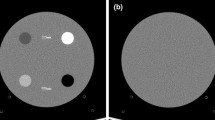Abstract
The purpose of this study was to evaluate, using simulated images with known property values, how accurately some computer applications for calculating modulation transfer function (MTF), task transfer function (TTF), or noise power spectrum (NPS) in computed tomography (CT) based on widely known techniques produce their results. Specifically, they were three applications applicable to the wire method for MTF calculation, two applications corresponding to the circular edge (CE) and linear edge (LE) methods for TTF, and one application using a two-dimensional Fourier transform for NPS, which are collectively integrated with the software ‘CTmeasure’ provided by the Japanese Society of CT Technology. Images for the calculation with radial symmetry were generated based on a roll-off type filter function. The accuracy of each application was evaluated by comparing the calculated property with the true one. The calculated MTFs for the wire method accurately matched the true ones with percentage errors of smaller than 1.0%. In contrast, the CE and LE methods presented relatively large errors of up to 50% at high frequencies, whereas the NPS’s errors were up to 30%. A closer investigation revealed, however, that these errors were attributable not to the applications but to the insufficiencies in the measurement techniques commonly employed. By improving the measurement conditions to minimize the effects of the insufficiencies, the errors notably decreased, whichvalidated the calculation techniques in the applications we used.







Similar content being viewed by others
References
Bischof CJ, Ehrhardt JC. Modulation transfer function of the EMI CT head scanner. Med Phys. 1977;4(2):163–7.
Hanson KM. Detectability in computed tomographic images. Med Phys. 1979;6(5):441–51.
Kijewski MF, Judy PF. The noise power spectrum of CT images. Phys Med Biol. 1987;32(5):565–75.
Nickoloff EL. Measurement of the PSF for a CT scanner: appropriate wire diameter and pixel size. Phys Med Biol. 1988;33(1):149–55.
Boedeker KL, Cooper VN, McNitt-Gray MF. Application of the noise power spectrum in modern diagnostic MDCT: part I. Measurement of noise power spectra and noise equivalent quanta. Phys Med Biol. 2007;52(14):4027–46.
AAPM Task Group 233, “Performance evaluation of computed tomography systems,” American Association of Physicists in Medicine, 2019, https://www.aapm.org/pubs/reports/detail.asp?docid=186.
Richard S, Husarik DB, Yadava G, Murphy SN, Samei E. Towards task-based assessment of CT performance: system and object MTF across different reconstruction algorithms. Med Phys. 2012;39(7):4115–22.
Takata T, Ichikawa K, Mitsui W, Hayashi H, Minehiro K, Sakuta K, et al. Object shape dependency of in-plane resolution for iterative reconstruction of computed tomography. Phys Med. 2017;33:146–51.
Ichikawa K, Kawashima H, Shimada M, Adachi T, Takata T. A three-dimensional cross-directional bilateral filter for edge-preserving noise reduction of low-dose computed tomography images. Comput Biol Med. 2019;111: 103353.
Sugisawa K, Ichikawa K, Urikura A, Minamishima K, Masuda S, Hoshino T, et al. Spatial resolution compensation by adjusting the reconstruction kernels for iterative reconstruction images of computed tomography. Phys Med. 2020;74:47–55.
Mori I, Machida Y. Deriving the modulation transfer function of CT from extremely noisy edge profiles. Radiol Phys Technol. 2009;2(1):22–32.
Kawashima H, Ichikawa K, Takata T, Nagata H, Hoshika M, Akagi N. Technical note: performance comparison of ultra-high-resolution scan modes of two clinical computed tomography systems. Med Phys. 2020;47(2):488–97.
Fujimura I, Ichikawa K, Miura Y, Hoshino T, Terakawa S. Comparison of physical image qualities and artifact indices for head computed tomography in the axial and helical scan modes. Phys Eng Sci Med. 2020;43(2):557–66.
Giger ML, Doi K, Metz CE. Investigation of basic imaging properties in digital radiography. 2. Noise wiener spectrum. Med Phys. 1984;11(6):797–805.
Hara T, Ichikawa K, Sanada S, Ida Y. Image quality dependence on in-plane positions and directions for MDCT images. Eur J Radiol. 2010;75(1):114–21.
Samei E, Richard S. Assessment of the dose reduction potential of a model-based iterative reconstruction algorithm using a task-based performance metrology. Med Phys. 2015;42(1):314–23.
Ichikawa K, Hara T, Niwa S, Ohashi K. Method of measuring modulation transfer function using metal wire in computed tomography. Nihon Hoshasen Gijutsu Gakkai Zasshi. 2008;64(6):672–80 ((in Japanese)).
Samei E, Flynn MJ, Reimann DA. A method for measuring the presampled MTF of digital radiographic systems using an edge test device. Med Phys. 1998;25(1):102–13.
Buhr E, Günther-Kohfahl S, Neitzel U. Accuracy of a simple method for deriving the presampled modulation transfer function of a digital radiographic system from an edge image. Med Phys. 2003;30(9):2323–31.
Fukunaga M, Onishi H, Matsutomo N, Yamamoto H. Accuracy of modulation transfer function for target size and field of view in a circular edge strategy using the CT image measurement program. Nihon Hoshasen Gijutsu Gakkai Zasshi. 2016;72(6):489–95 ((in Japanese)).
Urikura A, Hara T, Ichikawa K, Nishimaru E, Hoshino T, Yoshida T, et al. Objective assessment of low-contrast computed tomography images with iterative reconstruction. Phys Med. 2016;32(8):992–8.
Funding
This research did not receive any specific grant from funding agencies in the public, commercial, or not-for-profit sectors.
Author information
Authors and Affiliations
Corresponding author
Ethics declarations
Conflict of interest
The authors have no competing interests to declare that are relevant to the content of this article.
Ethical approval
This article did not contain any studies involving human participants.
Additional information
Publisher's Note
Springer Nature remains neutral with regard to jurisdictional claims in published maps and institutional affiliations.
About this article
Cite this article
Inoue, T., Ichikawa, K., Hara, T. et al. Validating computer applications for calculating spatial resolution and noise property in CT using simulated images with known properties. Radiol Phys Technol 17, 238–247 (2024). https://doi.org/10.1007/s12194-023-00771-w
Received:
Revised:
Accepted:
Published:
Issue Date:
DOI: https://doi.org/10.1007/s12194-023-00771-w




